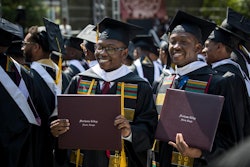By the year 2010, according to the National Science Foundation
(NSF), this country will need to produce 11,000 Ph.D.s in engineering
and science annually. Concurrently, the annual Ph.D. shortfall could be
about 9,600 by the year 2000.
This substantial shortfall cannot–and will not–be alleviated by
continued dependence upon the “good ole boy” network of traditional
sources of scientists and engineers. It will be physiologically
impossible for Yale, Harvard, Berkeley, Michigan, MIT, Stanford, and
Johns Hopkins universities–alone–to pick up the slack with regards to
our national needs as far as economic development is concerned.
This means that increasingly, as already signaled by the federal
government, there will be more and more dependence upon the
productivity by historically Black institutions.
Data compiled by the National Research Council show that from 1983
to 1987, HBCUs produced the largest percentage of Black Ph.D.s. And
according to the NSF, in 1988-89, the nation’s five top producers of
Black engineers with baccalaureate degrees were all HBCUs –North
Carolina A&T, Howard, Tuskegee, Prairie View A&M, and Southern.
The sixth was the City College of New York, which has a proportionately
large number of Black students.
The nation’s problems associated with the internationalization of
economic competition cannot be alleviated until it deals with the issue
of the underrepresentation of minorities and females in science and
technology. That means the federal government and the Fortune 500 must
find a way to enhance Black campuses. Any disparity that exists between
Black campuses and majority campuses–as far as facilities, missions,
and programs are concerned–threatens the ability to address those
problems.
On the one hand, Blacks are underrepresented in science and
technology. On the other hand, there is ample evidence to suggest that
HBCUs –which produce the largest number of Black scientists and
engineers–are sitting in a position of disequalization as far as
program mission and facilities equity are concerned.
For example, in 1993-94, according to the NSF’s list of top 100
research-producing universities receiving federal money for science and
engineering research, the institution that garnered the most federal
dollars was Johns Hopkins University, which received $701 million from
ten federal agencies. Number 100 on that list was the University of
Massachusetts-Worchester, which was awarded $36.6 million. There wasn’t
an HBCU on the list.
In contrast, of the eighty-one top research-producing Black
institutions to receive federal funds for research, Howard University
ranked first with $18.4 million.
Millions of these dollars were used for laboratory construction,
for the erection of science buildings, and for general infrastructure
enhancement. Given the importance that infrastructure enhancement has
for HBCUs, it is noteworthy that very little of the total pot went to
Black campuses.
Given the aforementioned industry shortfall, and the successful
track record of HBCUs and their production of Black scientists and
engineers, it is incumbent upon this nation to develop strategies and
delivery systems necessary to ensure that HBCUs get their fair share of
the research-grant pie.
HBCUs will survive to the extent that they are able to provide
their students with the kind of programmatic thrusts that will enable
them to prepare for their career-based place in the sun. The emphasis
should–and must–continue to be on academic quality and product.
Funding equity would greatly enhance the ability to maintain that
emphasis.
There is an inextricable relationship between the continued
economic growth of this nation and the strength and ability of its
colleges and universities to produce more scientists, engineers,
educators, businessmen, economists, and computer scientists. And the
reality is that the nation, when all is said and done, could care less
what color the university is or whether its student body is
predominantly Black, White, Asian, Native American, or Latino. The
nation’s major concern is product.
These campuses have produced 50 percent of the nation’s Black
business executives, 50 percent of its Black engineers, 75 percent of
its Black military officers, 80 percent of its Black federal judges,
and 85 percent of its Black physicians. And while the names of the
political, cultural, and social luminaries who attended these
institutions are too numerous to list here, it is obvious that some
kind of academic quality had to exist on these campuses in order for
them to take so many diamonds in the rough and polish them into jewels
that glisten for the entire world to see.
The goal of HBCUs is to insure the adequacy of preparation for
survival in an age of high technology while preserving the unique
history of the institution and the constituency that it, in the main,
represents. It is a goal worthy of greater respect–and support–from
the federal government and its funding agencies.
COPYRIGHT 1998 Cox, Matthews & Associates
© Copyright 2005 by DiverseEducation.com


















